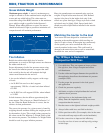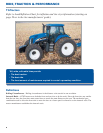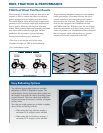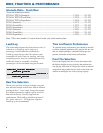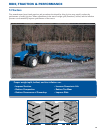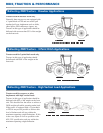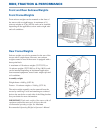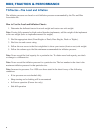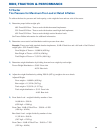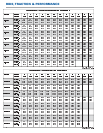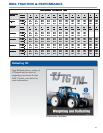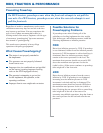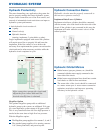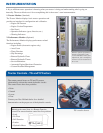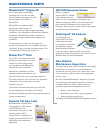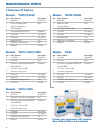
RIDE, TRACTION & PERFORMANCE
TJ Tractor
Tire Pressure for Maximum Tire Load at Rated Inflation
To achieve the best tire pressure and load capacity, scale weigh the front and rear axle of the tractor.
1) Determine proper ballast weight split.
60% Front/40% Rear - Tractor used with hitch mounted implements.
55% Front/45% Rear - Tractor used with drawbar towed high draft implement.
65% Front/35% Rear - Tractor used with high vertical drawbar loads.
See Tractor Ballast information for additional information.
2) Determine correct static load distribution and tire pressure from chart.
Example: Tractor used with standard drawbar implements, 18.4R-42 dual tires and a full tank of fuel. Desired
weight split = 55% Front/45% Rear.
Front Weight of Tractor = 14,000 lb (6350 kg)
Rear Weight of Tractor = 9392 lb (4260 kg)
Total Weight of Tractor = 23,392 lb (10610 kg)
3) Determine weight distribution by dividing front and rear weight by total weight.
Tractor Weight Distribution = 59.8% Front Axle
40.2% Rear Axle
4) Adjust the weight distribution by adding 2000 lb (907 kg) weight to the rear wheels.
Adjusted Weight:
Front weight = 14,000 lb (6350 kg)
Rear weight = 11,392 lb (5167 kg)
Total weight = 25,392 lb (11 517 kg)
Total weight distribution = 55.1% Front Axle
44.9% Rear Axle
5) Front Static Load - weight divided by number of tires.
14,000 lb/4 = 3500 lb
(6350 kg/4 = 1588 kg)
Front Chart: 18.4R-42 Dual Tires - 3500 lb = 9 PSI
(1588 kg = 62 kPa)
Rear Static Load - weight divided by number of tires.
11,392 lb/4 = 2848 lb
(5167 kg/4 = 1292 kg)
From Chart = 18.4R-42 Dual Tires - 2848 lb = 7 PSI
(1292 kg = 48 kPa)



